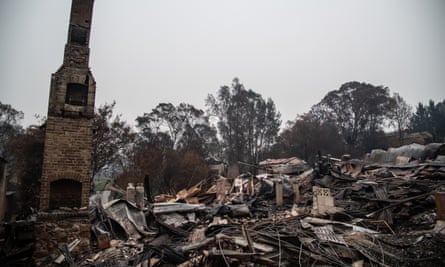Extract from The Guardian
The cost of responding to bushfires, storms and cyclones after the fact is likely to be 11 times greater, Apra warns

Last modified on Wed 14 Oct 2020 21.28 AEDT
Australia’s banking and insurance regulator has estimated the country should be spending about $3.5bn a year to limit damage from climate-related natural disasters, warning the cost of responding to them after the fact is likely to be 11 times greater.
In a speech on Wednesday, Geoff Summerhayes, an executive board member of the Australian Prudential Regulation Authority, said the cost of pre-emptive action to avoid the impact of disasters exacerbated by the climate crisis was far cheaper than dealing with the aftermath.
Addressing the issue of rising insurance premiums in northern Australia due to an increasing number of claims caused by storms and cyclones, Summerhayes said Apra was concerned general insurance could become unaffordable or unavailable in parts of the country.
He said it heightened the need to both cut greenhouse gas emissions and increase community resilience to extreme climate events, such as last summer’s catastrophic bushfires.
“Investing in the types of resilience, mitigation and hazard reduction measures needed to better protect Australian communities – and keep insurance affordable and accessible – comes at a cost,” he told an Australian Business Roundtable webinar. “But as we witnessed last summer, failing to take action can be far more costly in the long run, and the price paid is often far more valuable than can be measured in dollars.”
Summerhayes
cited research by the business roundtable that predicted the total
economic cost of natural disasters in Australia would reach $39bn a year
by 2050. Based on evidence from the US that every $1 spent on
resilience measures saves up to
$11 in response and recovery costs,
he said covering those losses would require the community to invest
about $3.5bn a year to prevent the worst impacts.
“That’s an enormous sum, but it’s much smaller than the $39bn cost,” he said.
Summerhayes has previously warned climate change posed a material risk to the entire financial system and urged companies to start adapting.
Australia’s insurers have estimated they faced paying out $5.4bn on almost 300,000 claims related to last summer’s bushfires, floods and hailstorms. Summerhayes said the country’s financial sector and broader economy, backed by government support, were strong enough to absorb and bounce back from this and the additional cost of rebuilding damaged roads, bridges, electricity and water supplies. But he said that resilience would be tested should “last summer’s experience become the new normal”.
“Alarmingly, the clear message from Australian and global scientific experts suggests this may be the case,” he said. “The Bureau of Meteorology says Australia’s climate has warmed just over 1C in recent decades, contributing to a long-term increase in extreme fire weather and the length of the fire season. The Australian Academy of Science warns the link between human-induced climate change and extreme weather is clear, and we must start preparing for a more dangerous future.”
He said residents of northern Australia were already bearing the cost, with average home insurance premiums jumping more than 178% and home and contents packages rising 122% since 2007, prompting the consumer watchdog to warn they were becoming unaffordable. The rate of households without insurance in the north is almost double the rest of the country.
Summerhayes said the cost of claims kept rising, mainly due to storms and cyclones, and rebuilding costs were greater than in the south. It was resulting in a growing reluctance among some insurers, particularly smaller operators, to offer cover in high-risk areas.
He said there was evidence that investment in dealing with natural disasters was already saving taxpayers. The Bushfire and Natural Hazards Cooperative Research Centre estimated enhanced flood mitigation measures in the Tasmanian city of Launceston saved $240m when major flooding hit the region in 2016.
He praised the “growing number of outstanding examples” of community groups, businesses and other organisations combining resources and expertise to seek to protect community interests, highlighting the mining magnate Andrew Forrest’s Minderoo Foundation for its “audacious” goal of ensuring no dangerous bushfire would burn longer than an hour by 2025.
He noted the treasurer, Josh Frydenberg, had foreshadowed more announcements on disaster and mitigation funding following the release of the final report from the royal commission into bushfires.
“While not a substitute for global action to reduce the emissions fuelling rising temperatures, the royal commission provides an important opportunity to make increasing the physical resilience of the community to natural disasters a national priority,” he said. “We either buy now or we pay more later.”
The speech was welcomed by the Insurance Council of Australia, which repeated its call for greater natural disaster resilience funding. “Without mitigation, the damage bill in vulnerable communities – northern Australia in particular – will continue to soar,” the council’s chief executive, Andrew Hall, said.
No comments:
Post a Comment